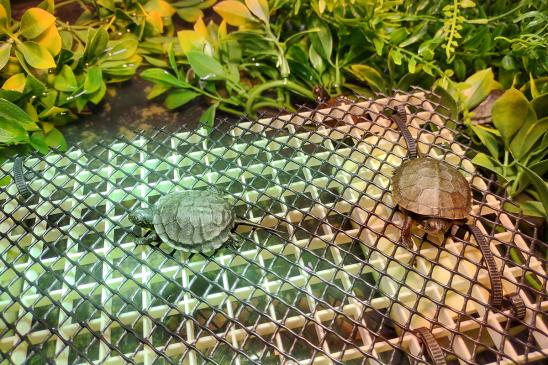-
About
- Leadership & Faculty
- News & Events
-
Academics
- Graduate
- Advanced Clinical Training
- Continuing Education
- Academic Departments
- Academic Offices
- Simulation Experiences
-
Student Life
- Offices
-
Research
-
Hospitals & Clinics
- Emergency Care
- Hospital Services
-
Community Outreach
- Volunteer
Head-starting Rare Turtles and Tracking Turtles via Radiotelemetry
First Person by Rick Rego, McGrath Veterinary Laboratory Manager

In September, 25 students from the Association of Amphibian and Reptile Veterinarians Student Chapter (AARV) and the Theriogenology Club at Cummings School of Veterinary Medicine at Tufts University traveled to Dighton, Massachusetts, to visit the Bristol County Agricultural High School (BCAHS). The tour focused on the turtle head-starting labs and the state- and federal-turtle confiscation labs in the Natural Resources/Environmental Conservation department at the school. The labs are in the Center for Science and the Environment – a state-of-the-art three-story science building that was part of a $100 million-plus rebuild of school facilities several years ago.
BCAHS has a long history of head-starting rare and endangered turtles, raising and releasing almost 3,000 turtles across eleven species. Nearly all these turtles are native to New England, and BCAHS works with several state and private agencies to head-start them and conduct research on the science behind this conservation tool.
They have head-started chicken turtles (Deirochelys) and Chinese box turtles (Coura) for several organizations, including the Turtle Survival Alliance. In addition to head-starting, they serve as a depository for turtles seized at airports and in poaching operations, working with state and federal authorities to type these turtles to specific regions or watersheds through blood sampling. The goal is to release these animals back into the wild or into placement with accredited AZA (Association of Zoos & Aquariums) facilities. BCAHS works closely with several zoos and veterinarians on this project.
Tufts students toured all the labs at the school (in descending order of strict biosecurity protocols), working with turtles and other reptiles and amphibians. They also visited the marine science labs, where several projects are underway, including head-starting horseshoe crabs and a beginning project on seahorses.
The last lab featured the educational animal lab, where students got to handle various animals. After the lab tours, students headed into the forested part of the beautiful 300-acre campus, situated on the Taunton River, to practice radiotelemetry for turtle tracking and research. Several BCAHS students from the Natural Resources major 3-D printed and painted mock Eastern box turtle shells and planted a radio in each one, then hid them in a small patch of forested land on campus. Tufts students learned about the radios and tracking equipment used in turtle work, and practiced handling them to find the planted mock turtles. Many students got involved, trying their hand at locating each turtle with the radio array. BCAHS is a highly biodiverse campus, and several amphibians were found while tracking the turtles, including both native treefrog species, a wood frog, and red-backed salamanders.
A great big thanks to Brian Bastarache and the BCAHS Natural Resources students for hosting Tufts for the day, and to Mairead Ryan, V27, for arranging this with the ARAV and Theriogenology Clubs.
